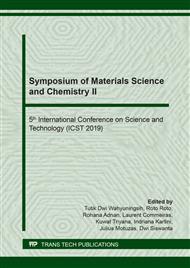[1]
B.L. Mordike, T. Ebert, Magnesium: Properties-applications-potential, Mater. Sci. Eng. A 302 (2001) 37-45.
Google Scholar
[2]
J. Walker, S. Shadanbaz, T.B.F. Woodfield, M.P. Staiger, G.J. Dias, Magnesium biomaterials for orthopedic application: A review from a biological perspective, J. Biomed. Mater. Res. B Appl. Biomater. 102 (2014) 1316-1331.
DOI: 10.1002/jbm.b.33113
Google Scholar
[3]
Q. Chen, G.A. Thouas, Metallic implant biomaterials, Mater. Sci. Eng. R 87 (2015) 1-57.
Google Scholar
[4]
Y. Wei, B. Liu, L. Hou, B. Xu, G. Liu, Characterization and properties of nanocrystalline surface layer in Mg alloy induced by surface mechanical attrition treatment, J. Alloys Compd. 452 (2008) 336-342.
DOI: 10.1016/j.jallcom.2006.11.079
Google Scholar
[5]
M. Laleh, F. Kargar, Effect of surface nanocrystallization on the microstructural and corrosion characteristics of AZ91D magnesium alloy, J. Alloys Compd. 509 (2011) 9150-9156.
DOI: 10.1016/j.jallcom.2011.06.094
Google Scholar
[6]
H.Q. Sun, Y.N. Shi, M.X. Zhang, Sliding wear-induced microstructure evolution of nanocrystalline and coarse-grained AZ91D Mg alloy, Wear 266 (2009) 666-670.
DOI: 10.1016/j.wear.2008.08.004
Google Scholar
[7]
S. Xia, Y. Liu, D. Fu, B. Jin, J. Lu, Effect of surface mechanical attrition treatment on tribological behavior of the AZ31 alloy, J. Mater. Sci. Technol. 32 (2016) 1245-1252.
DOI: 10.1016/j.jmst.2016.05.018
Google Scholar
[8]
G. Chen, J. Gao, Y. Cui, H. Gao, X. Guo, S. Wu, Effects of strain rate on the low cycle fatigue behavior of AZ31B magnesium alloy processed by SMAT, J. Alloys Compd. 735 (2018) 536-546.
DOI: 10.1016/j.jallcom.2017.11.141
Google Scholar
[9]
D. Fabijanic, A. Taylor, K.D. Ralston, M.X. Zhang, N. Birbilis. Influence of surface mechanical attrition treatment attrition media on the surface contamination and corrosion of magnesium, Corrosion 69 (2013) 527-535.
DOI: 10.5006/0763
Google Scholar
[10]
N. Li, Y.D. Li, Y.X. Li, Y.H. Wu, Y.F. Zheng, Y. Han, Effect of surface mechanical attrition treatment on biodegradable Mg–1Ca alloy, Mater. Sci. Eng. C Mater. Biol. Appl. 35 (2014) 314-321.
DOI: 10.1016/j.msec.2013.11.010
Google Scholar
[11]
C.O. Hoog, N. Birbilis, Y. Estrin, Corrosion of pure Mg as a function of grain size and processing route, Adv. Eng. Mater. 10 (2008) 579-582.
DOI: 10.1002/adem.200800046
Google Scholar
[12]
B. Arifvianto, Suyitno, M. Mahardika, Degradation of mechanically surface treated AZ31B Magnesium alloy in 3.5 wt.% NaCl solution, Mater. Sci. Forum 948 (2019) 237-242.
DOI: 10.4028/www.scientific.net/msf.948.237
Google Scholar
[13]
N. Birbilis, K.D. Ralston, S. Virtanen, H.L. Fraser, C.H.J. Davies, Grain character influences on corrosion of ECAPed pure magnesium, Corros. Eng. Sci. Techn. 45 (2010) 224-230.
DOI: 10.1179/147842209x12559428167805
Google Scholar
[14]
B. Arifvianto, Suyitno, M. Mahardika, Surface morphology, roughness and wettability of the medical grade 316L stainless steel processed with surface mechanical attrition treatment and electropolishing for the preparation of osteosynthesis plate, J. Phys. Sci. 29 (2018) 83-94.
DOI: 10.21315/jps2018.29.3.7
Google Scholar
[15]
B. Arifvianto, Suyitno, M. Mahardika, P. Dewo, P.T. Iswanto, U.A. Salim, Effect of surface mechanical attrition treatment (SMAT) on microhardness, surface roughness and wettability of AISI 316L, Mater. Chem. Phys. 125 (2011) 418-426.
DOI: 10.1016/j.matchemphys.2010.10.038
Google Scholar
[16]
B. Arifvianto, Suyitno, M. Mahardika, Effect of sandblasting and surface mechanical attrition treatment on surface roughness, wettability, and microhardness distribution of AISI 316L, Key Eng. Mater. 462-463 (2011) 738-743.
DOI: 10.4028/www.scientific.net/kem.462-463.738
Google Scholar
[17]
A. Pardo, M.C. Merino, A.E. Coy, R. Arrabal, F. Viejo, E. Matykina, Corrosion behaviour of magnesium/aluminium alloys in 3.5 wt.% NaCl, Corros. Sci. 50 (2008) 823-834.
DOI: 10.1016/j.corsci.2007.11.005
Google Scholar
[18]
L. Wang, T. Shinohara, B.P. Zhang, H. Iwai, Characterization of surface products on AZ31 magnesium alloy in dilute NaCl solution, J. Alloys Compd. 485 (2009) 747-752.
DOI: 10.1016/j.jallcom.2009.06.071
Google Scholar


